Different wavelengths of light (electromagnetic waves) create different sensations of color. For example, objects that reflect wavelengths of light in the range of 620 to 750 nanometers (roughly 200 time smaller than the width of a human hair) appear red/orange to us. The sensation of green / yellow is produced by light in the 495-570 nanometer wavelength range, and blue/violet is perceived when light of 380-450 wavelength range falls on the eye's color sensors (cones). Figure 1 shows the rainbow spectrum with corresponding wavelengths that generate the sensation of the different colors. Our eyes have three types of cones each sensitive to a range of wavelengths—with quite a bit of overlap.
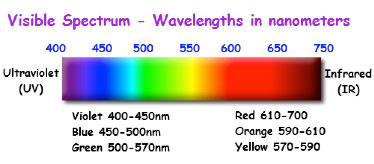
Figure 1:
Different wavelengths of light produce different sensations of color.
Source:
chemistry.tutorcircle.com
Wavelengths above or below these aren't visible to us, so we don't call them "light". For example, we don't see the microwave radiation inside a microwave oven because it's wavelength is way longer than what our cones can detect. At the other extreme we don't see the radiation from dental X-rays because the wavelengths are in the order of a hundred times too small. Figure 2 shows where our eyes stand in terms of their ability to see electromagnetic waves. Note each tick on the scale represents a factor of 10.
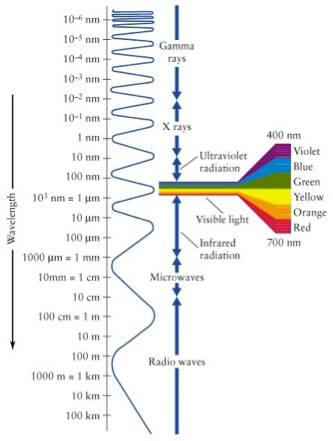
Figure 2: The human eye can detect a very small portion of the electromagnetic wavelength spectrum. The portion we are able to see, we call "light." Red appears on the long side of the electromagnetic wavelength range, violet appears on the short side. Source: science-edu.larc.nasa.gov
Yet looking at the rainbow—which supposedly represents all the colors—we are bound to think, "But I can see many more colors than just what's in a rainbow." Where's pink, olive and salmon, for example? The Answer is that bubblegum pink is about 255 parts red, 192 parts green and 203 parts blue. So, our eye/brain system is able to perceive more colors than just what's in the rainbow by mixing the signals from the retina's red sensitive, green sensitive and blue sensitive receptors. In fact, a crayon box that had all the colors we can see would include 10 million crayons! If the wavelengths of light coming from the viewed object activate the red sensitive cones strongly but not so much the green or blue sensitive cones, we see a saturated red like a tomato, but if the wavelengths reflected by the object stimulate the other receptors to a greater degree then we see subtler colors that don't show up in a rainbow, such as salmon. Figure 3 shows the wavelength responses of the three-color receptors in our retinas.
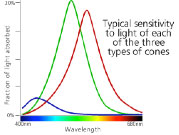
Figure 3: Sensitivity of the eye's three-color receptors (cones) to different wavelengths of light. A couple of things to notice: 1. our eyes are most sensitive to green (tallest peak) and least sensitive to blue (shortest peak). 2. There is considerable overlap between the curves. For example, light at the peak of the green curve also stimulates the red and blue cones—though to a lesser extent. Can you find the wavelength(s) that activates only one type of receptor? I cant! Source: deron.meranda.us
This is a simple theory of color perception, known as the trichromatic theory. It is as though the cone signal strengths from the three different types of cones go to a look-up table in the brain where, depending on relative strength of these color channels, a particular color is perceived.
This theory explains a lot about color perception but not everything. For example why is there no color that is perceived as reddish green, or yellowish blue, while reddish blue (Beets) and yellowish green (ripening bananas) are quite imaginable? Or why when we stare at the funny- colored flag (in figure 4) for 20 seconds and then look at a white sheet of paper we see the flag in its right colors. Turns out that the straight look-up table theory isn't everything there is to color perception. In fact, the color cones in our eyes are wired together into slightly higher level neural circuits that set some pairs of color stimuli in opposition to each other. For example a neural circuit output can be actually inhibited by a green stimulus even as it is excited by red. Such "color opponency" circuits make color perception more complex and interesting than just the sum of three separate color inputs. The after image of the funny-colored flag appears in real flag colors because its colors are "opponent" to the real flag colors. Figure 5 is a diagrammatic representation of the "color opponent process" neural wiring between the cones.
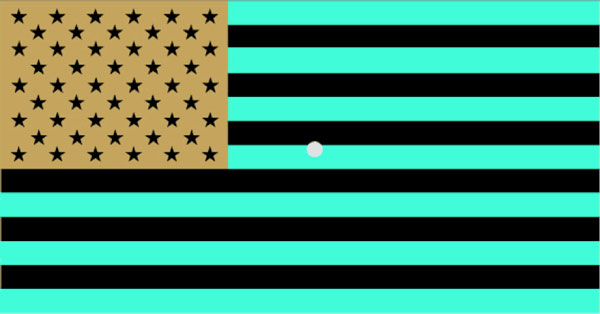
Figure 4: Stare at the white dot in the center of the flag for about 20 seconds, then look at a white piece of paper (or a white part of the computer screen). You will see an after image with the flag in its Fourth of July colors.
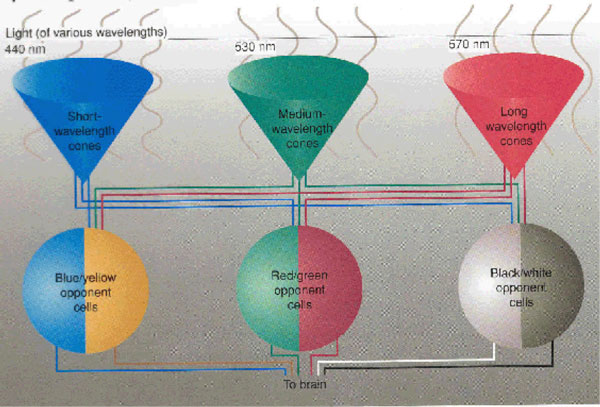
Figure 5: Diagrammatic representation of neural wiring among retinal color receptors. The brain does not receive the outputs for the three types of color-sensitive cells directly. There are in-between processing circuits where blue/yellow, red/green, and bright/dark opponency channels are created. As a consequence of this neural wiring, fatiguing a cone by staring at its corresponding color creates the sensation of the opposite color when the stimulus is removed (i.e. when we stop staring at the flag).
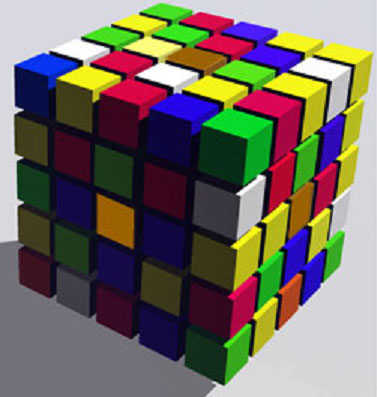
Figure 6: Another color phenomenon that is not explained by the trichromatic theory. Compare the central tile on the side facing us with the central tile on the top surface. They look yellow and brown respectively. Yet they are emitting exactly the same wavelengths of light at exactly the same intensities. Try covering the rest of the colored tiles and just comparing the two squares. The explanation likely includes the "black/white" opponency channel in the Figure 5 diagram : one of the cube's faces is in bright light while the other is in the dark.
More in my next article on color...

Ari Siletz is president of CCDMETRIX. His company specializes in automated vision system inspection and metrology. With a background in both optical and software engineering, Ari has been developing instruments for the the ophthalmic and optical coating industries since the 1980s. Writing is one of Ari's serious hobbies. He is a published author whose short stories have appeared in numerous literary anthologies. He lives in Sebastopol, California.










